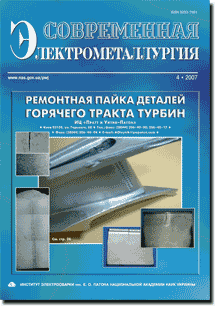| 2007 №03 | 2008 №01 |

CONTENTS

ELECTROSLAG TECHNOLOGY
Kompan Ya.Yu., Nazarchuk A.T. and Protokovilov I.V. Towards the problem of intensification of electromagnetic action in magnetically-controlled electroslag melting of titanium alloys 2
The effect of a longitudinal constant magnetic field on technological and metallurgical peculiarities of the process of magnetically-controlled electroslag melting of titanium alloys was investigated. It was shown that the use of a pulsed action makes it possible to refine the structure of melted ingots, preserving the high quality of their formation. Conditions of a pulsed electromagnetic action for melting titanium ingots of 80-140 mm diameter have been developed.
Tsykulenko K.A. Progress of electroslag technologies and updating of designs of ESR moulds (Review) 7
Different types of designs of moulds, as well as the methods of producing ingots and castings, both used only in lab practice and also widely in industry, are considered. The updating of designs is described depending on various demands of the electroslag production. Advantages of electroslag processes in a current-carrying mould, problems occurring at the present stage, and also possible trends of development are shown.
ELECTRON BEAM PROCESSES
Ustinov A.I., Fesyun E.V., Melnichenko T.V. and Romanenko S.M. Effect of substrate temperature on micro- and substructure of copper condensates deposited from a vapor phase 18
Effect of temperature of substrate on micro- and substructure of copper condensates, formed from a vapor phase by the method of electron beam evaporation, was investigated. It was established that the decrease in temperature of the substrate leads not only to the decrease in sizes of grains of the copper condensates, but also to the qualitative change in their substructure, i.e. nanotwins are formed by the system {111}, <112>. The change in substructure of copper condensates is accompanied by an abrupt increase in their microhardness.
PLASMA-ARC TECHNOLOGY
Shapovalov V.A., Nikitenko Yu.A., Burnashev V.R. and Torkhov G.F. Measurement of temperature of drum-cooler in the process of super-rapid hardening of metal melted in plasma furnace 25
Problems of calorimetry of a rotating drum-cooler during super-rapid hardening of the melt are considered. Optimum scheme of measurement was selected. Investigations were carried out allowing determination of heat transfer between the melt and drum-cooler.
GENERAL PROBLEMS OF METALLURGY
Khizhnyak V.G., Pomarin Yu.M., Kurilo N.A. and Medova I.Yu. Diffusion coatings on the base of titanium, vanadium and chromium carbides on steel U8A 28
Phase composition, structure, microhardness, crack resistance of carbide coatings of titanium, vanadium, chromium on steel U8A are investigated. Experimental data about wear resistance of steel U8A with carbide coatings, obtained during tests under different conditions of friction are given: sliding friction without lubricant with and without preliminary grinding of surface and friction by a fixed abrasive. It was established that the carbide coatings increase the wear resistance of steel U8A by 2.5Д20 times.
Malashenko I.S., Kurenkova V.V., Belyavin A.F., Trokhimchenko V.V., Chervyakova L.V. and Lebedevich Ya.B. Structure and strength properties of brazed joints of cast nickel alloy JS26NK. Part 1 31
Materials science specifics of formation of brazed joints of cast nickel alloy JS26NK is considered. Physical-mechanical properties of the brazed joints produced by using standard boron-containing brazing alloy and brazing alloy, having silicon as the second depressant, as well as different binders, are given. It was shown that the use of a binder in the form of solution of acrylic acid in acetone is effective in case of application of composite brazing alloys containing 20% of powder of the industrial alloy NiД12 % Si (NS12). Strength and fracture toughness of the brazed joint of alloy JS26NK, attained at room temperature, exceed the similar characteristics of alloy JS26VI. Relation between mechanical properties of the brazed joints and direction of prevailed growth of dendrites in the brazed metal was demonstrated.
Postizhenko V.K. and Efimenko G.G. Analysis of the state-of-the-art and problems of development of continuous casting of steel in metallurgy of Ukraine 39
Review of development of structure of the process of a continuous casting of steel during recent 50 years is presented. The share of the continuous casting in countries with a developed steel making production in the 1990s approached 100%. At the beginning of the XXI century a jump was made in the technology of steel production, thus marking the beginning of the industrial manufacture of hot-rolled strips using casting-rolling technologies which are priority now in steel casting.
ELECTROMETALLURGY OF STEEL AND FERROALLOYS
Panchenko A.I., Salnikov A.S., Logozinsky I.N., Korol L.N., Kazakov S.S., Gasik M.I. and Gorobetz A.P. Comparative experimental-industrial investigations of effect of 65 % ferrosilicium with different content of calcium on contamination of steel ShKh15SG-V with globular alumocalcium inclusions 46
Results of comparative investigations of effect of 65 % ferrocilicium with different content of calcium on contamination of steel ShKh15SG-V with globular alumocalcium inclusions were summarized and analyzed. It was established that the application of imported 65 % ferrosilicium with 0.08 % Ca reduces the calcium content in steel as compared with a filler of ferrosilicium of grade FS65 with 0.42 % Ca (DSTU 4127Д02) and decreases the amount of globular inclusions in billets and ready metal products. However, the contamination of metal with oxide inclusions is increased in this case.
REVIEWS AND SCIENTIFIC DISCUSSIONS
Lakomsky V.I. Concerning the article of G.A. Tsybulkin «On issue of dependence of the carbon granular material electric properties upon pressure and size of fractions» 53
INFORMATION
Repair brazing of parts of the turbine hot path 56
Developed at PWI 27, 38, 45, 55
Index of articles for AEM'2007, Nos. 1-4 57
(You are viewing the simplified file contents)
